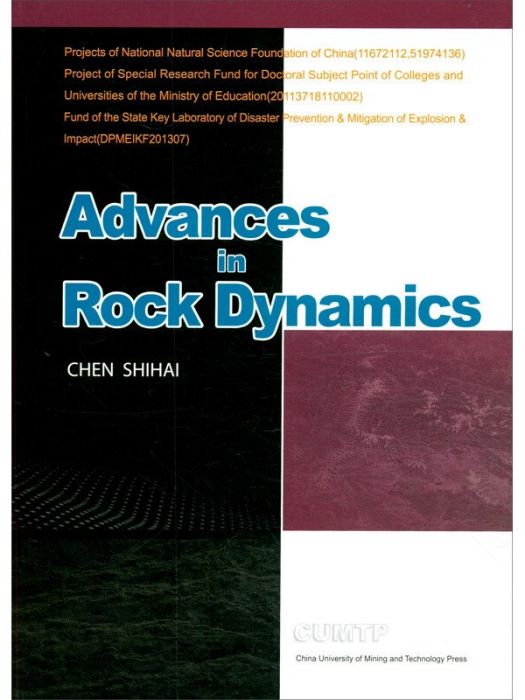《岩土動力學研究進展(英文版)》是2020年1月1日中國礦業大學出版社出版的圖書,作者是陳士海。
基本介紹
- 中文名:岩土動力學研究進展(英文版)
- 作者:陳士海
- 出版社:中國礦業大學出版社
- ISBN:9787564645076
內容簡介,圖書目錄,
內容簡介
This book is the main research achievements made by the author in rock blasting vibration effect and underground engineering dynamic disaster in recent years,including the mechanism of blasting vibration source,the influence of blasting source factors on blasting vibration,the human blasting vibration effect,the charge blasting vibration waveform prediction theory,the wave propagation mechanism of tunnelling blasting,dynamic disturbance creep characteristics of rock,the nonlinear deformation characteristics and failure mechanism as well as testing method of deep underground caverns and supporting structure under the action of blasting dynamic load and high ground stress,rock burst mechanism,etc.
Although the book is published in the form of research essays,but its content is still a strong system and integrity. Most of the results compiled are published in important academic journals and international conferences at home and abroad,such as Journal of Engineering Mechanics ASCE,Tunnelling and Underground Space Technology,Environmental Earth Sciences,Journal of Central South University,Journal of Testing and Evaluation,Journal of Mountain Science,Journal of Rock Mechanics and Engineering,Rock and Soil Mechanics,Vibration and Shock,etc.,they profoundly reflect the latest achievements of the dynamic development of the explosive load on the rock and Structure. This book can be used as study and reference for geotechnical engineering,mining engineering,underground engineering,protection engineering and other professional teachers and students,scientific research workers and engineers.
圖書目錄
Chapter 1 Blasting Source Equivalent Load on Elastic-Plastic Boundary for Rock Blasting
1.1 Introduction
1.2 Elastic-plastic wave propagation characteristics of blasting
1.3 The blasting elastic-plastic control equations and their solutions
1.4 Stress on elastic-plastic boundary and blasting source load simplification
1.5 Conclusions
Acknowledgements
References
Chapter 2 The Influence of the Millisecond Time, Charge Length and Detonation Velocity on Blasting Vibration
2.1 Introduction
2.2 The blasting vibration characteristics of short cylindrical charge
2.3 Law of multi-hole millisecond blasting vibration
2.4 The effects of charge length and detonation velocity on blasting vibration
2.5 Conclusions and discussions
References
Chapter 3 Prediction of Surface Vibration Waveform Caused by Tunnel Blasting
3.1 Introduction
3.2 Theoretical surface vibration waveform function of spherical charge blasting
3.3 Constructed vibration waveform function of spherical charge blasting
3.4 Vibration waveform function of single hole cylindrical charge blasting
3.5 Influence analysis of tunnel surrounding rock grade to vibration
3.6 Engineering case
3.7 Conclusions
Acknowledgements
References
Chapter 4 Human Comfort Evaluation Criteria for Blast Planning
4.1 Introduction
4.2 Mechanical vibration comfort evaluation method
4.3 Energy assessment for blasting vibration comfort criteria
4.4 Comfort investigation and evaluation criteria
4.5 Criteria evaluation using a case study
4.6 Conclusions and discussions
References
Chapter 5 The Propagation Characteristics of Vibration Waves Induced in Surrounding Rock by Tunnelling Blasting
5.1 Introduction
5.2 The analytical solution of blasting vibration wave propagation in the surrounding rock
5.3 Analytic and numerical calculation
5.4 Conclusions
Acknowledgements
References
Chapter 6 Blasting Vibration Safety Criteria for Shotcrete in Underground Engineering
Chapter 7 Analytical Study on the Response of Rock Bolts to Blasting Vibrations
Chapter 8 Experimental Study on Dynamic Response Characteristics of Rock and Support
Chapter 9 Study on Unloading Cracking Area of Deep Rock Tunnel Excavation
Chapter 10 Time-space Effects of Deep Tunnel Excavation and Its Visco-elastic-plastic Analysis
Chapter 11 Triaxial Creep Disturbance Test of Rock and Its Mechanical Characteristics
Chapter 12 Research on Conventional Triaxial and Dynamic Disturbance Damage of Rock Based on D-P Criterion and Weibull Distribution

